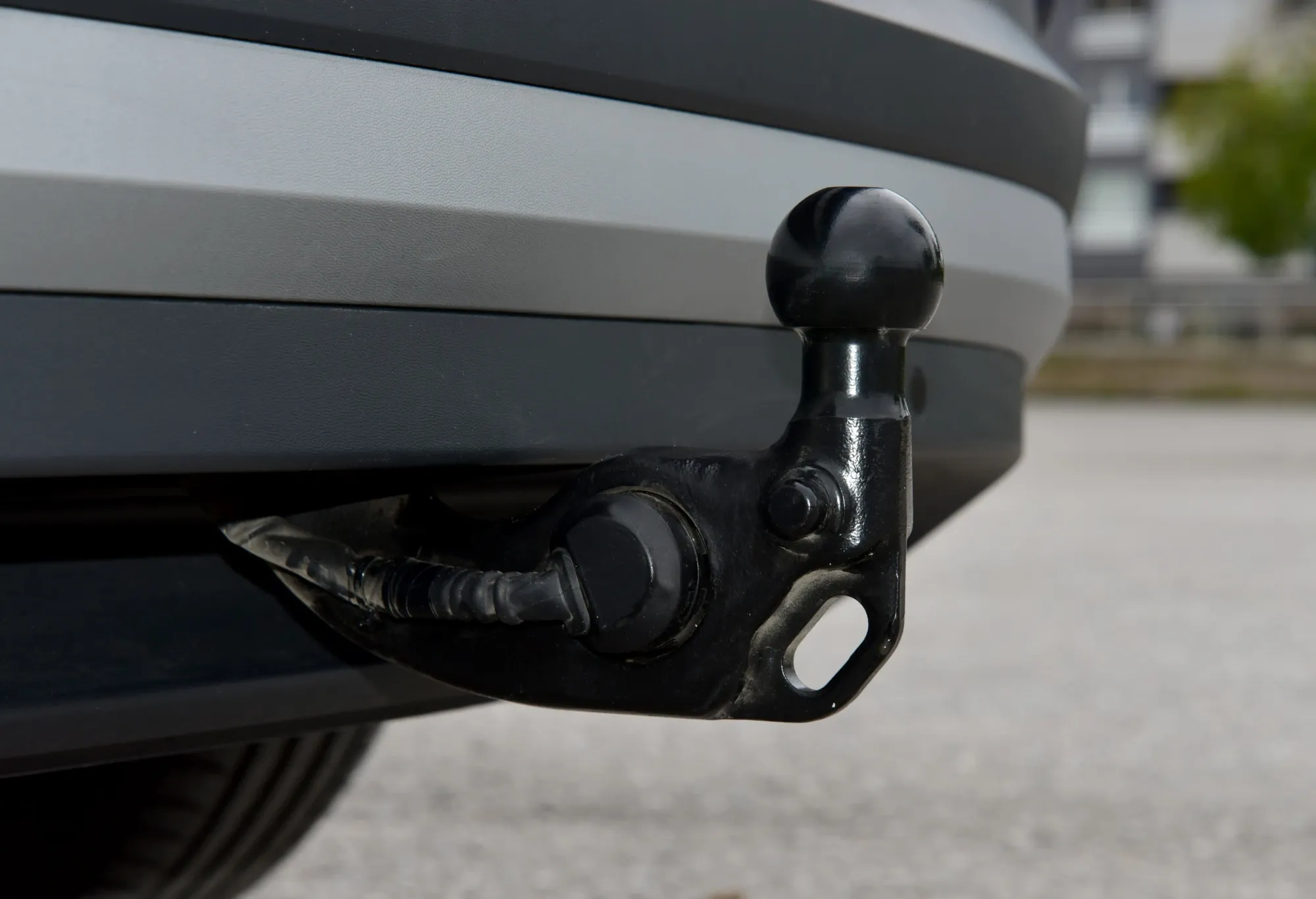Towing a trailer safely in the UK depends largely on choosing the right type of tow bar (or tow hitch) for your vehicle and intended use.
Below is an overview of the most common types and their differences.
Fixed Tow Bars
Fixed tow bars are mounted permanently to the vehicle chassis, meaning they are always present, whether you are towing or not.
They are typically less expensive than detachable systems and are often the simplest option for regular towing.
Fixed flange tow bar
A “flange” tow bar uses a flat metal plate (the flange) that is bolted directly to the underside of the vehicle.
The tow ball is attached to this flange, often using 2 or 4 bolt fittings.
Advantages of fixed-flange tow bars:
- Versatile: they can accommodate accessories such as bike racks, bumper guards and stabilisers, and can tow or carry bikes while towing.
- They are typically the most cost-effective option.
- Disadvantages:
- They are more bulky than other types; they may interfere with rear parking sensors or restrict access to the boot.
Gooseneck tow bar
The gooseneck design features a curved neck (similar to a swan's neck) that ends in the tow ball.
This design tends to be more aerodynamic and less obtrusive than a flange.
Advantages:
- More elegant and aesthetic.
- Less likely to activate reverse sensors.
- Less likely to interfere with access to the boot or rear of the vehicle.
- Disadvantages:
- Less versatile than a tow bar with accessory flange; for example, some bike racks or bumper guards may not be compatible.
Mobile or retractable tow bars
These systems allow the tow ball (or the entire tow bar assembly) to be removed or hidden when not in use, improving the aesthetics of the vehicle and avoiding interference with parking sensors or boot access.
Detachable tow bar with flange
Also known as a tow bar with detachable flange: similar to the fixed flange version, a flange plate provides the mounting point, but the tow ball assembly can be removed when not in use.
Advantages:
- When removed, the tow bar is not visible, providing a clean look and avoiding interference with parking sensors.
- Accessories designed for flange tow bars (e.g. bike racks, bumper protectors) can still be used. Disadvantages:
- They are usually more expensive than fixed versions.
Detachable towbar with gooseneck
When not in use for towing, the gooseneck and ball can be removed, leaving little or no trace of the towbar.
Advantages:
- Clean appearance when removed; minimal interference with parking sensors or boot access.
- Disadvantages:
- Less suitable for some accessories (e.g. certain types of bike racks) compared to clamp-on systems.
Retractable tow bars
Some manufacturers offer tow bars that can be retracted, folded or slid into place, so that the tow ball is hidden when not in use.
This combines the strength of a fixed tow bar with the discretion of a detachable system.
Advantages:
- Invisible when not in use for towing.
- Maintains the same safety and load capacity as a fixed tow bar.
- Possible drawbacks:
- They are usually more expensive and can be more complex to install.
Types of hitches for agricultural trailers
When it comes to agricultural trailers or heavy trailers (e.g. agricultural machinery, livestock trailers, heavy loads), the types of hitches may differ from standard hitches for towing cars and caravans.
Pivot hitch
Features:
- Uses a hook and lunette ring coupling system instead of a standard tow ball.
- Excellent for heavy loads and off-road conditions, it offers great articulation, ideal for the uneven terrain often found on farms.
Gooseneck hitch
Features:
- Gooseneck hitches are mounted on the flatbed (or suitable structure) of a pick-up lorry (usually) or towing vehicle and use a ball and coupler system similar in some ways to standard trailers.
- They are designed for very heavy loads and provide better stability and weight distribution, which is an advantage when towing trailers or heavy agricultural equipment.
Fifth wheel hitch
Features:
- This system is common on large-scale trailers, such as semi-trailers, where a pivot on the trailer attaches to a corresponding mechanism on the towing vehicle.
- Although less common on standard cars, it is sometimes relevant for larger agricultural or industrial trailers or when a heavier trailer is required.
Frequently asked questions
What type of trailer can be towed with a B driving licence?
In the UK, a standard B driving licence (for cars) usually allows you to tow a trailer, but you must ensure that:
- The combined weight of the vehicle and trailer does not exceed the limits set out in the licence conditions or your vehicle's towing capacity. Some common fixed and detachable tow bars are approved for typical caravan or trailer loads.
- The trailer is compatible with your vehicle's tow bar or hitch. For lighter trailers (e.g. small box trailers or utility trailers), a simple tow bar or gooseneck tow bar may suffice; for heavier or agricultural trailers, more robust hitches such as pivots, goosenecks or fifth wheels may be required.
Does it need to pass an MOT?
No. There is no requirement to have it inspected at the MOT.
You can wait until the next standard inspection, when they will check that it is correctly fitted.
Is any certification required?
Yes, tow bars (and towbars) must have a certificate of approval (or marking) indicating that they comply with the required safety and regulatory standards.
This ensures that the towbar is suitable for use on the road and capable of safely supporting the rated loads.
In addition, when towing heavier trailers (especially agricultural or commercial trailers), it must be ensured that the class of coupling, load capacity and type of coupling are suitable for the type and weight of the trailer.
Insurers or authorities may require documentation of capacities.
